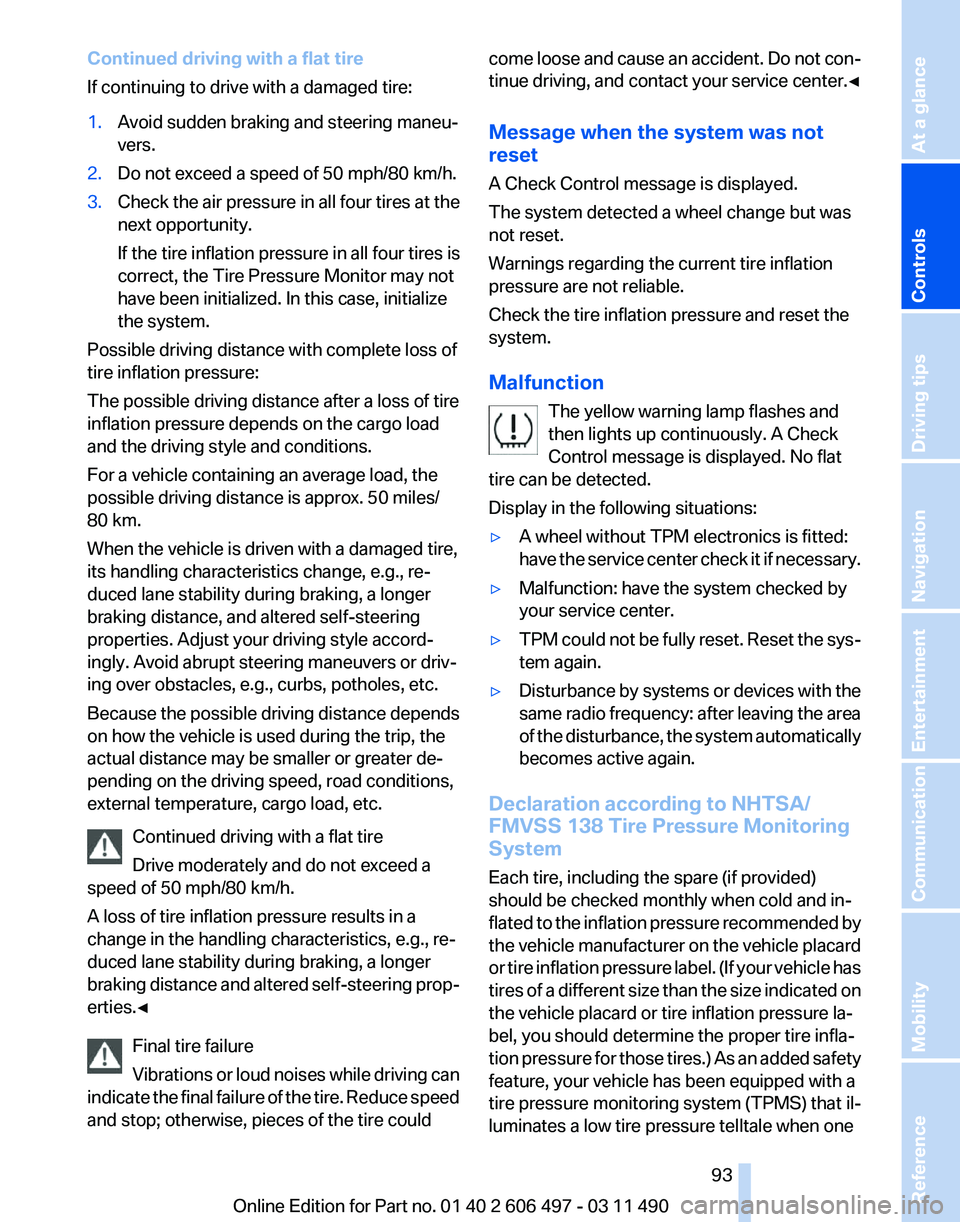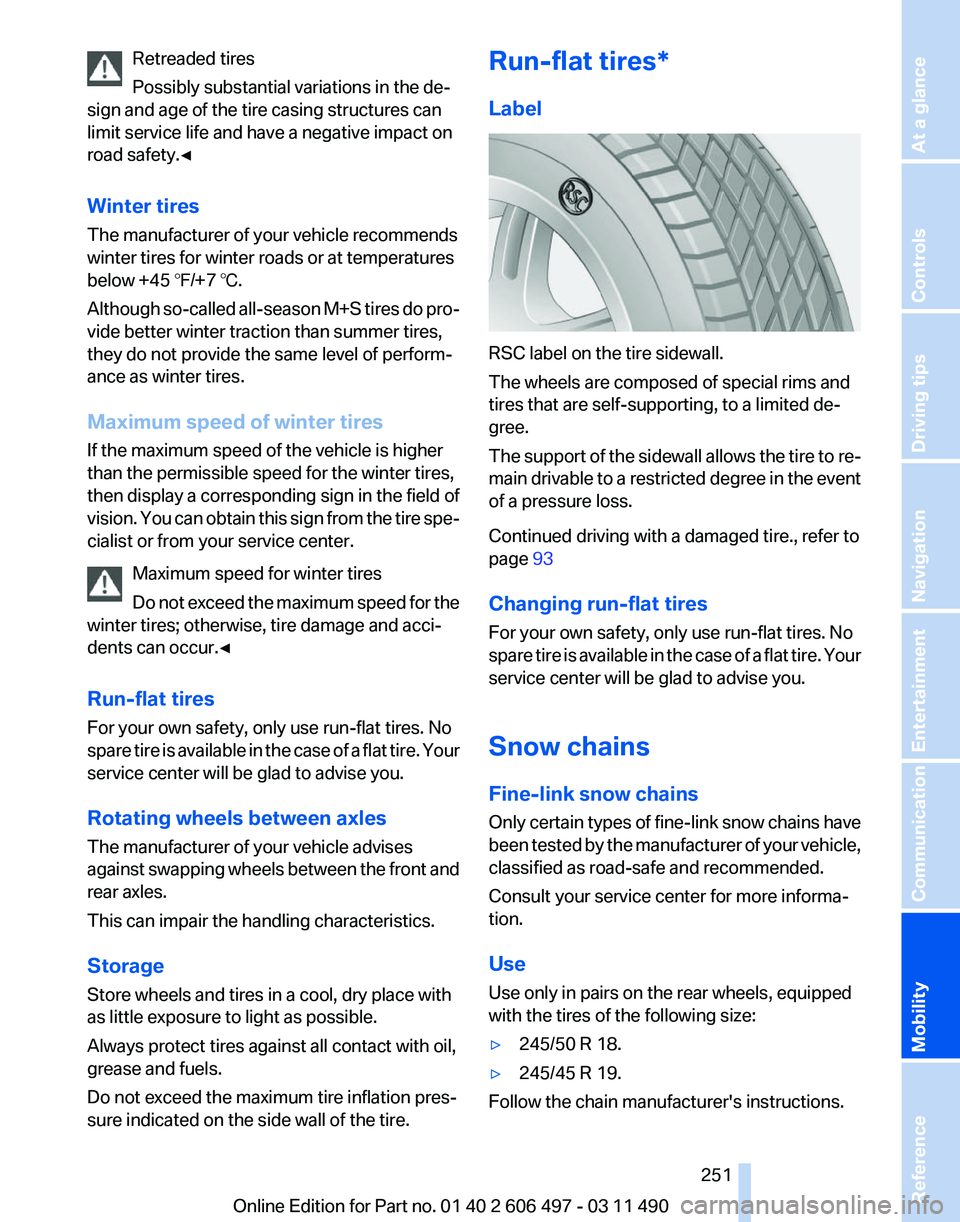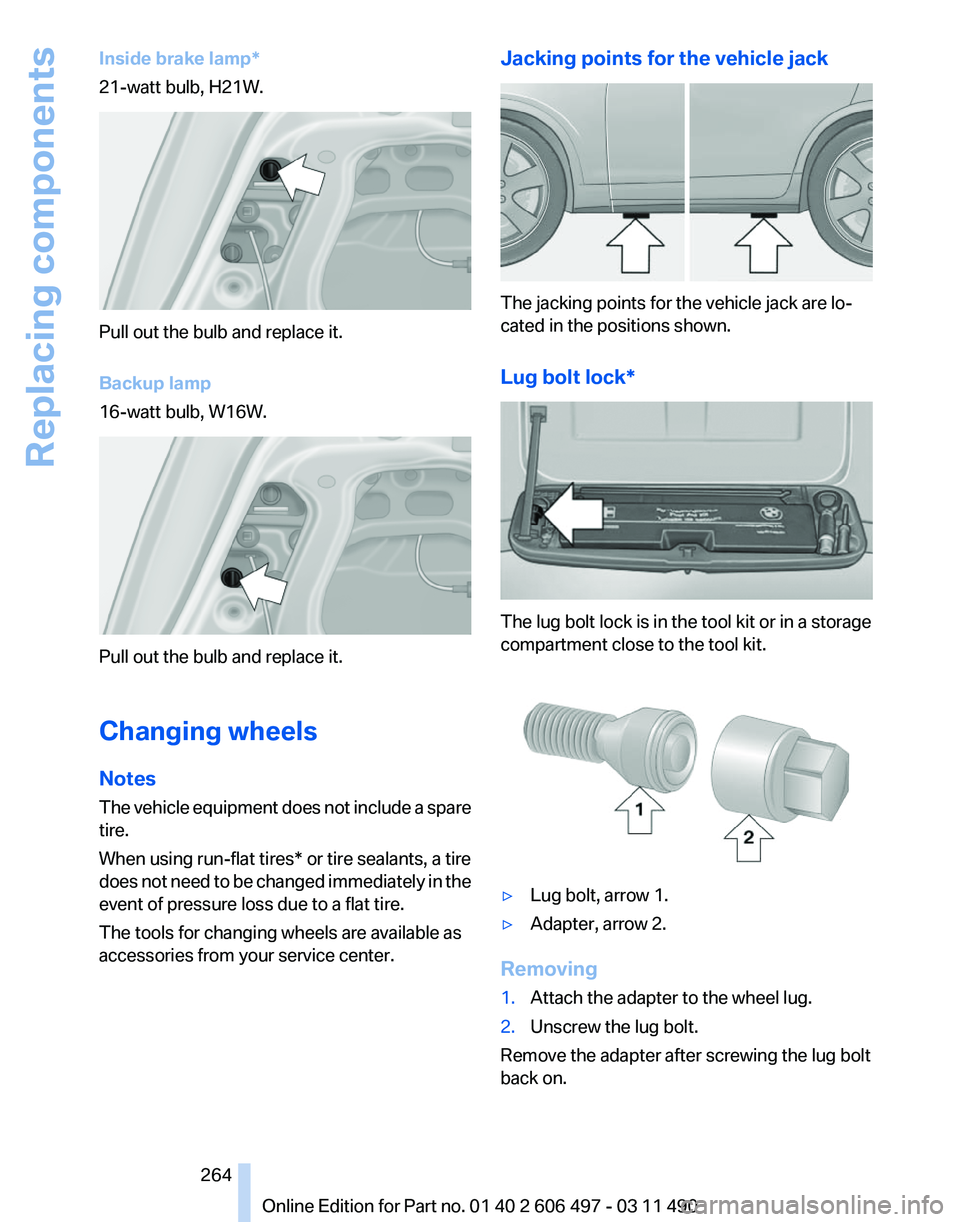2012 BMW 750LI SEDAN spare tire
[x] Cancel search: spare tirePage 93 of 299

Continued driving with a flat tire
If continuing to drive with a damaged tire:
1.
Avoid sudden braking and steering maneu‐
vers.
2. Do not exceed a speed of 50 mph/80 km/h.
3. Check the air pressure in all four tires at the
next opportunity.
If the tire inflation pressure in all four tires is
correct, the Tire Pressure Monitor may not
have been initialized. In this case, initialize
the system.
Possible driving distance with complete loss of
tire inflation pressure:
The possible driving distance after a loss of tire
inflation pressure depends on the cargo load
and the driving style and conditions.
For a vehicle containing an average load, the
possible driving distance is approx. 50 miles/
80 km.
When the vehicle is driven with a damaged tire,
its handling characteristics change, e.g., re‐
duced lane stability during braking, a longer
braking distance, and altered self-steering
properties. Adjust your driving style accord‐
ingly. Avoid abrupt steering maneuvers or driv‐
ing over obstacles, e.g., curbs, potholes, etc.
Because
the possible driving distance depends
on how the vehicle is used during the trip, the
actual distance may be smaller or greater de‐
pending on the driving speed, road conditions,
external temperature, cargo load, etc.
Continued driving with a flat tire
Drive moderately and do not exceed a
speed of 50 mph/80 km/h.
A loss of tire inflation pressure results in a
change in the handling characteristics, e.g., re‐
duced lane stability during braking, a longer
braking distance and altered self-steering prop‐
erties.◀
Final tire failure
Vibrations or loud noises while driving can
indicate the final failure of the tire. Reduce speed
and stop; otherwise, pieces of the tire could come loose and cause an accident. Do not con‐
tinue
driving, and contact your service center.◀
Message when the system was not
reset
A Check Control message is displayed.
The system detected a wheel change but was
not reset.
Warnings regarding the current tire inflation
pressure are not reliable.
Check the tire inflation pressure and reset the
system.
Malfunction The yellow warning lamp flashes and
then lights up continuously. A Check
Control message is displayed. No flat
tire can be detected.
Display in the following situations:
▷ A wheel without TPM electronics is fitted:
have
the service center check it if necessary.
▷ Malfunction: have the system checked by
your service center.
▷ TPM could not be fully reset. Reset the sys‐
tem again.
▷ Disturbance by systems or devices with the
same
radio frequency: after leaving the area
of the disturbance, the system automatically
becomes active again.
Declaration according to NHTSA/
FMVSS 138 Tire Pressure Monitoring
System
Each tire, including the spare (if provided)
should be checked monthly when cold and in‐
flated
to the inflation pressure recommended by
the vehicle manufacturer on the vehicle placard
or tire inflation pressure label. (If your vehicle has
tires of a different size than the size indicated on
the vehicle placard or tire inflation pressure la‐
bel, you should determine the proper tire infla‐
tion pressure for those tires.) As an added safety
feature, your vehicle has been equipped with a
tire pressure monitoring system (TPMS) that il‐
luminates a low tire pressure telltale when one Seite 93
93Online Edition for Part no. 01 40 2 606 497 - 03 11 490
Reference Mobility Communication Entertainment Navigation Driving tips
Controls At a glance
Page 251 of 299

Retreaded tires
Possibly substantial variations in the de‐
sign and age of the tire casing structures can
limit service life and have a negative impact on
road safety.◀
Winter tires
The manufacturer of your vehicle recommends
winter tires for winter roads or at temperatures
below +45 ℉/+7 ℃.
Although
so-called all-season M+S tires do pro‐
vide better winter traction than summer tires,
they do not provide the same level of perform‐
ance as winter tires.
Maximum speed of winter tires
If the maximum speed of the vehicle is higher
than the permissible speed for the winter tires,
then display a corresponding sign in the field of
vision. You can obtain this sign from the tire spe‐
cialist or from your service center.
Maximum speed for winter tires
Do not exceed the maximum speed for the
winter tires; otherwise, tire damage and acci‐
dents can occur.◀
Run-flat tires
For your own safety, only use run-flat tires. No
spare tire is available in the case of a flat tire. Your
service center will be glad to advise you.
Rotating wheels between axles
The manufacturer of your vehicle advises
against swapping wheels between the front and
rear axles.
This can impair the handling characteristics.
Storage
Store wheels and tires in a cool, dry place with
as little exposure to light as possible.
Always protect tires against all contact with oil,
grease and fuels.
Do not exceed the maximum tire inflation pres‐
sure indicated on the side wall of the tire. Run-flat tires*
Label
RSC label on the tire sidewall.
The wheels are composed of special rims and
tires that are self-supporting, to a limited de‐
gree.
The
support of the sidewall allows the tire to re‐
main drivable to a restricted degree in the event
of a pressure loss.
Continued driving with a damaged tire., refer to
page 93
Changing run-flat tires
For your own safety, only use run-flat tires. No
spare tire is available in the case of a flat tire. Your
service center will be glad to advise you.
Snow chains
Fine-link snow chains
Only certain types of fine-link snow chains have
been tested by the manufacturer of your vehicle,
classified as road-safe and recommended.
Consult your service center for more informa‐
tion.
Use
Use only in pairs on the rear wheels, equipped
with the tires of the following size:
▷ 245/50 R 18.
▷ 245/45 R 19.
Follow the chain manufacturer's instructions.
Seite 251
251Online Edition for Part no. 01 40 2 606 497 - 03 11 490
Reference
Mobility Communication Entertainment Navigation Driving tips Controls At a glance
Page 264 of 299

Inside brake lamp*
21-watt bulb, H21W.
Pull out the bulb and replace it.
Backup lamp
16-watt bulb, W16W.
Pull out the bulb and replace it.
Changing wheels
Notes
The
vehicle equipment does not include a spare
tire.
When using run-flat tires* or tire sealants, a tire
does not need to be changed immediately in the
event of pressure loss due to a flat tire.
The tools for changing wheels are available as
accessories from your service center. Jacking points for the vehicle jack The jacking points for the vehicle jack are lo‐
cated in the positions shown.
Lug bolt lock*
The lug bolt lock is in the tool kit or in a storage
compartment close to the tool kit.
▷
Lug bolt, arrow 1.
▷ Adapter, arrow 2.
Removing
1. Attach the adapter to the wheel lug.
2. Unscrew the lug bolt.
Remove the adapter after screwing the lug bolt
back on.
Seite 264
264 Online Edition for Part no. 01 40 2 606 497 - 03 11 490
Replacing components
Page 295 of 299

Seats 48
Seats, rear, adjusting 51
Seat ventilation, front 51
Seat ventilation, rear 53
Selection list in instrument cluster 77
Selector lever, automatic transmission 73
Self-leveling suspension, air suspension 101
Self-leveling suspension, mal‐ function 102
Sensors, care 273
Service and warranty 7
Service requirements, CBS Condition Based Serv‐
ice 258
Service requirements, dis‐ play 81
Service, Roadside Assis‐ tance 267
Settings on Control Dis‐ play 80
Settings, storing for seat, mir‐ rors, steering wheel 57
Shifting, automatic transmis‐ sion 72
Short commands 280
Shoulder support 49
Side airbags 88
Side View 118
Signaling, horn 12
Signals when unlocking 37
Sitting safely 48
Size 276
Ski bag 136
Slide/tilt glass roof 46
Smallest turning circle 277
Smoker's package 134
Snap-in adapter, mobile phone 221
Snow chains 251
Socket 134
Socket, OBD Onboard Diag‐ nostics 258
Software applications, iPhone 238
Software update 197 Spare fuse 265
Special destinations, naviga‐ tion 155
Specified engine oil types 256
Speed, average 78
Speed limit, setting 79
Speedometer 14
Split screen 23
Split
screen map settings 163
Spoken instructions, naviga‐ tion 161
SPORT+ program, Dynamic Driving Control 103
SPORT program, Dynamic Driving Control 103
Sport program, transmis‐ sion 74
Stability control systems 98
Start/Stop button 65
Start function during malfunc‐ tion 33
Starting aid 267
Starting the engine 65
State/province, selecting for navigation 152
Stations, stored 178
Station, storing 172
Status display, tires 91
Status information, iDrive 22
Status of Owner's Manual 6
Steering, Integral Active Steering 101
Steering wheel, adjusting 60
Steering wheel heating 60
Steering wheel memory 57
Steptronic, automatic trans‐ mission 72
Stopping the engine 66
Storage compartments 138
Storage compartments, loca‐ tions 138
Storage, tires 251
Storing the vehicle 273
Street, entering for naviga‐ tion 153
Summer tires, tread 249 Supplementary text mes‐
sage 83
Surround View 115
Suspension settings 102
Switch for Dynamic Driving Control 102
Switch-on times, parked-car ventilation 131
Switch, refer to Cockpit 12
Symbols 6
T
Tachometer 76
Tail and brake lamps 263
Tailgate 39
Tailgate, automatic 40
Tailgate
via remote control 37
Tail lamps 263
Tail lamps, bulb replace‐ ment 263
Tasks 229
Technical changes, refer to Safety 7
Technical data 276
TeleService 234
Temperature, automatic cli‐ mate control 126
Temperature display, external temperature 76
Temperature, engine oil 76
Tempomat, refer to Active Cruise Control 105
Terminal, starting aid 268
Text messages 226
Text message, supplemen‐ tary 83
Theft alarm system, refer to Alarm system 43
Theft protection, lug bolts 264
Theft protection, refer to Cen‐ tral locking system 35
Thermal camera, refer to Night Vision 120
Thigh support 48
Tilt alarm sensor 44
Tilt, seats 48
Seite 295
295Online Edition for Part no. 01 40 2 606 497 - 03 11 490
Reference Mobility Communication Entertainment Navigation Driving tips Controls At a glance